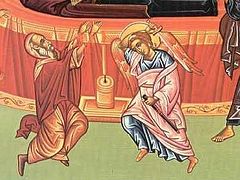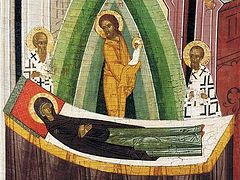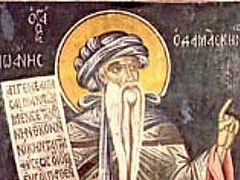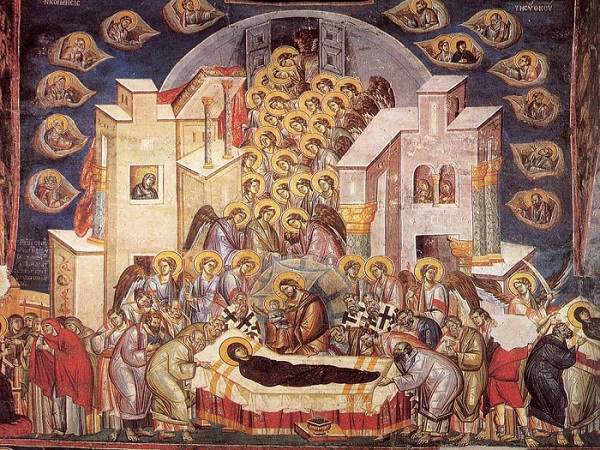
There are many feasts of the Mother of God, commemorating the events of her life, her intercessions for us after her death, and her innumerable miraculous icons. Her most significant and solemn feast is certainly her Dormition which includes her bodily Assumption, commemorated on August 15/28 and preceded by two weeks of fasting. The feast is often known as the “summer Pascha,” and is celebrated with great pomp throughout the Orthodox world. For instance, in Jerusalem on August 12/25 a Liturgy is served at Little Gethsemane, followed by a Molieben and a procession with her burial shroud to her sepulcher in Gethsemane proper, in which all the members of the Russian Spiritual Mission participate. On the morning of August 14/27 the clergy, monastics, and faithful embark upon a two-hour procession from the Jerusalem Patriarchate which culminates in the service of Lamentations[1] at the Gethsemane Skete, where is placed the burial shroud of the Mother of God amidst fragrant flowers and myrtle and adorned with precious coverings. On the Apodosis of the feast (August 23/Sept. 5) the burial shroud is returned in another solemn procession.[2] This is but one of the celebrations throughout the Orthodox world that could be described that demonstrate the great love for the Theotokos that resides in the hearts of the Orthodox faithful.

Following the resolution of the Nestorian controversy in 433, public veneration of the Theotokos in liturgical and artistic settings took on greater importance and spread rapidly. Several churches and monasteries were built in her honor in the fifth century, and she was celebrated throughout the whole empire on a day before or after the Nativity since the late fourth century. The ancient Armenian lectionary from Jerusalem compiled between 412 and 439 lists the commemoration of the Mother of God on August 15 in the Church of the Kathisma,[3] and the feast was made obligatory in the East as a celebration of her Dormition by Emperor Maurice (582-602).[4]
Interest in the death of Mary existed in Palestine by the late fourth century, possibly connected with the tradition surrounding her tomb in the Kedron Valley. An early witness to this interest is St. Epiphanius of Salamis, and his words are surprising. He writes, “[N]or do I say that she remained immortal; but I also will not say definitively that she died. For the Scripture goes far beyond the human mind, and has left this point undecided because of the surpassing dignity of that vessel [of God] …” and “If the holy Virgin died and was buried, her falling-asleep was honorable and her end holy; her crown consisted in her virginity … Or else she remained alive; for it is not impossible for God to do whatever [H]e wills. In fact, no one knows her end.”[5] This ambiguity is compatible with the Roman Catholic dogma of the Assumption of Mary which was proclaimed on November 1, 1950 by Pope Pius XII and states: “the Immaculate Mother of God, the ever Virgin Mary, having completed the course of her earthly life, was assumed body and soul into heavenly glory” (emphasis added). Following this intentional ambiguity, Roman Catholics are free to believe that she died, or not, but it is clear that by the time of Emperor Maurice’s decree the feast was universally understood to include both her death and Assumption, and this is the unquestionable understanding of the Orthodox Church.[6]
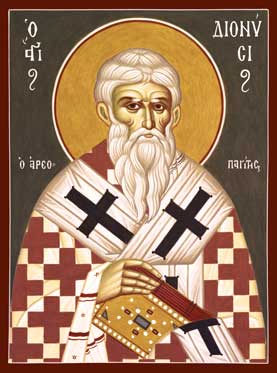 St. Dionysius the Areopagite, a witness to the Dormition
St. Dionysius the Areopagite, a witness to the Dormition Through the hymns for the feast of the Dormition and the Synaxarion the Church depicts the story of Mary’s passing from this life and her translation into Heaven. Having asked to be given notice of her coming repose, the Archangel Gabriel appeared to the Mother of God three days prior, announcing her coming sleep and handing her a palm branch from Paradise which indicated that in death she would overcome corruption. Rejoicing at the news she went to pray on the Mount of Olives where even the trees bowed in reverence to her. She then returned home and prepared herself for her burial. Her friends lamented that they were losing her but she assured them that she would continue to pray for them and the whole world. Suddenly there was a noise like thunder and her house was filled with the Apostles who had been miraculously gathered from around the world to bid farewell to the Theotokos—all except for the Apostle Thomas. Having taken leave of all present she prayed to Christ for peace throughout the world and gave up her holy soul to her Son and God Who had appeared with the Archangel Michael and a host of angels. According to some texts, Christ personally received her soul because she had prayed that He would preserve her from seeing the grotesqueness of the demons of the aerial toll houses.[10] As was her childbearing, her death was painless.
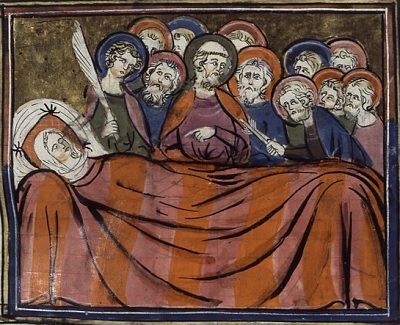
It should be noted that although the Orthodox Church has not “formally” proclaimed the Assumption of Mary as has the Catholic Church, it is no less an unwavering teaching of the Orthodox Church, as seen in its hymnographic, hagiographic, and Patristic literature. Thus the oft-made assertion that it is “not dogmatic” is problematic because it gives the false impression that the faithful Orthodox Christian can justifiably deny the Assumption of Panagia, and fails to recognize the many avenues through which the Church proclaims the glory of Her truths. Her tomb in Jerusalem is indeed empty.
Flowery language and theological reflections characterize the Patristic homilies on the Dormition and Assumption of the Theotokos. Two major points of emphasis are the Virgin’s incorrupt death and Assumption as a confirmation of the work of Christ that will culminate in the general resurrection of all mankind and her continuing and heightened role as intercessor for all mankind. Her death is a mystery, as St. Andrew of Crete says,[13] and the final mystery bestowed upon her, rooted in the Mystery of Christ’s triumph over death. For St. Maximus, as Christ and His Mother have overturned the law of pleasure and pain through His pleasureless and painless birth, and as Christ has defeated death by His death and Resurrection, transforming it from a condemnation of human nature into a condemnation of sin, the same becomes true of the saints, first of all and especially the Theotokos.[14] The same is true for St. John of Damascus who says that she overcame nature by her unique childbearing and therefore “It was fitting that she, who preserved her virginity undamaged by childbirth, should have her body preserved from corruption in death,”[15] and thus her passing is referred to as a “deathless Dormition.”[16] Although she was above nature, she submitted to the corruption of death as had her Son: “Imitating your Creator and Son, above nature you submit to the laws of nature.”[17] She was a little lower than the angels through mortality, but “by her proximity to the God of all … she has ascended higher than the angels and the archangels and all the hosts that are found beyond them.”[18] According to St. Andrew of Crete because she was so intimately tied into the economy of salvation her life cannot simply end in death.[19]
Commenting on St. Gregory Palamas’ statement that “she, like her Son, yielded for a short time to nature”[20] (emphasis added), Dr. Christopher Veniamin writes that, according to St. Maximus, we can even go so far as to say her death was by economy and therefore voluntary, and that the same is true of all the righteous in Christ.[21] Elsewhere Dr. Veniamin writes:
Following the regeneration of our nature through baptism and the seal of the Holy Spirit (i.e. chrismation), our mortal and passable bodies are such only by divine economy, see St. Maximus the Confessor, Letters to Thalassius LXI (PG 90:625-645), inasmuch as the saints voluntarily lay down their lives (as did Christ), even though they are blameless and innocent. Their innocence means that sin, and therefore death too, has no hold over them. Thus, their innocent and unjust death is like that of Christ, and signifies their triumph (through Christ) over the devil and death.[22]
 The Theotokos, who intercedes for all men
The Theotokos, who intercedes for all men The Theotokos is the greatest advocate of men before God. It is to her that we flee after God Himself and her petitions fill our services and prayers. She is truly the mother of the Church and her abundant love overflows on us all. At the wedding at Cana she interceded before her Son, her last act on earth was to pray for peace, and she continues in this role in an inestimably greater capacity now that she is body and soul in Heaven with Christ. This is a continual theme in Patristic Dormition homilies. It is treated by St. John of Thessalonica, who teaches that Christ has mercy on those who praise His mother, Theoteknos of Livias, St. Theodore the Studite, St. John Maximovitch, etc. [27] She is especially praised in this capacity by St. Germanus of Constantinople: “In times of tribulation you are near, and we find safety in seeking your help; and when it is time to rejoice, you are joy’s sponsor. Whenever we find ourselves completely under your maternal care, we cannot help believing that you live among us … every faith-filled heart runs towards you … every right-believing Christian bears you on his lips.”[28] He even conceives of her as the central channel of grace: “[N]o one is saved but through you, Mother of God; no one is free of danger but through you, Mother of God; no one is redeemed but through you, Mother of God …”[29] St. John of Damascus writes that through her entry into Heaven she has won for us all good things, and St. Gregory Palamas writes that she forevermore bestows her blessings upon all of creation, as she promised just before her repose.[30]
Because she is closest to God she is able to intercede more powerfully than all, including the angels.[31] It is because her prayers benefit much before the Lord that we call on her constantly in life and it is even to her that we turn for protection at the moment of, and after our death. St. Ephraim of Syria supplicates: “O my Lady, do not leave me in the terrible hour of death, but hasten to my aid and deliver me from the bitter torments of the demons. For if thou choosest, thou has the power to accomplish this, for thou art truly the Mother of God, who reignest over all,”[32] and the same is asked every evening at the service of Small Compline. Prior to her soul’s entrance into Heaven she was shown the horrors of Hades by the Archangel Gabriel that she might have greater compassion on those who suffer. This is referred to in the hymnography of the Church.[33] According to Archimandrite Vassilios Bakoyannis she entreated Christ to have mercy on the souls that suffer there and so they are given respite between Pascha and Pentecost each year, and for this reason the Royal Doors remain open, the Saturday of Pentecost is dedicated to the departed, and the third kneeling prayer of Pentecost is a supplication for the departed.[34] In this way she continues to bring consolation to even those in physical and spiritual death. She is the Ark in the heavens residing with her Son. She is quick to hear, and the joy of all who sorrow because she fervently entreats the Lord on our behalves. This is enshrined in the Kontakion of the feast of the Dormition: “Neither the tomb, nor death could hold the Theotokos, Who is constant in prayer and our firm hope in her intercessions. For being the Mother of Life, She was translated to life by the One who dwelt in her virginal womb.”

